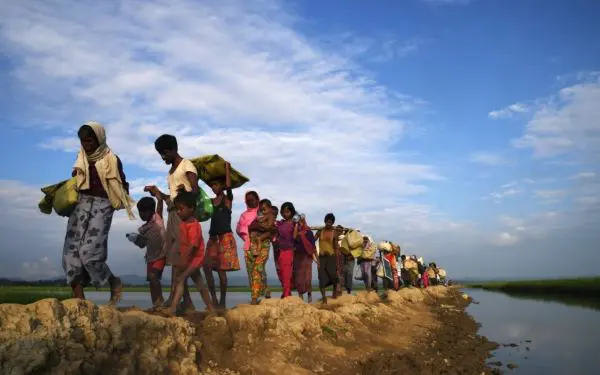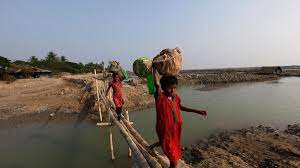We have heard the alarming data: in 2022, global carbon dioxide emissions reached an all-time high and July 2023 was declared the hottest month ever recorded.
We have seen the fires in the Amazon rainforest, the heavy rains that have impacted Beijing and the floods that various countries have experienced in recent weeks. In Latin America we have felt heat waves and deep droughts worsen conditions in the Central American Dry Corridor.
Surely we have already heard Antonio Guterres, Secretary General of the United Nations, vehemently maintain that we are no longer in the time of global warming, but that we have already reached the “age of boiling.”
We live in times of climate emergency and, in this context, it seems that we already have all the information about what is happening in our countries, in the region or in the world. But, even with data that arrives like tidal waves, the truth is that there are stories about climate change that remain on the margins of the conversation: those of climate displaced people.
Human mobility for climate reasons
People in situations of human mobility for climate reasons are those who have had to move internally, within their own countries, or internationally, as a consequence of the effects of the climate emergency. These can be fast-onset effects, such as hurricanes or floods, or slow-onset effects, such as desertification or sea level rise. These effects can push people to displacement in two ways: as direct triggers, for example in the case of inhabitants of islands that are flooded, or because they deepen other structural causes of human mobility, usually in regions or communities that are already vulnerable.
The region of Mexico and Central America is one of the most vulnerable to the impacts of climate change, not only in relation to the geographical location of the isthmus, but also due to the structural inequalities that cross this region and, therefore, its population is also more exposed to movement.
An example of this is that, after hurricanes Eta and Iota in Guatemala, Honduras and Nicaragua, more than 225 thousand people were forcibly displaced due to the destruction of their homes and the inability to access food or drinking water. Another example is the cases of forced displacement linked to cycles of acute drought in the Dry Corridor of Central America, where, according to the Food and Agriculture Organization of the United Nations (FAO), food insecurity has left 3.5 million people in need of humanitarian assistance in Guatemala, Honduras and El Salvador.
These situations are worsened by risks that already pushed the population to mobilize, such as organized crime, violence, the social and environmental impacts of megaprojects, corruption or democratic instability.
Therefore, it is very complex to quantify the effects on human mobility derived from climate change, particularly those that appear slowly, since the socioeconomic effects are usually the most visible causes of displacement, thereby dismissing the final impact of the climate crisis on the population. life of the people
Even so, the projections for the coming years are alarming: it is estimated that, by 2050, around 4 million people in Mexico and Central America will be forced to move as a consequence of climate change.

The climate diaspora continues
Faced with this panorama, however, instead of advancing on routes for mitigation and adaptation and on ways to protect the rights of displaced people, the reality is that the climate diaspora continues, to a large extent, invisible.
Hence, as “what is not named, does not exist”, and for what does not exist, for what is not seen, narrated or quantified, public policies, norms or protection standards cannot be generated either. That is, the disinterest of the authorities; challenges in data and information collection; and the lack of attention or documentation of these displacements by the Mesoamerican countries have translated into the lack of public policies to comprehensively address these displacements. Thus, the climate diaspora faces a situation of absolute lack of state protection.
It should be noted that, under the current immigration policy and the international legal system, to access any type of national or international state protection and, to be able to exercise a series of rights, it is necessary to fit within a legal category that provides said protection. For example, being recognized as a refugee guarantees that people who need international protection are not returned or expelled to countries where their life or personal integrity is at risk.
The 1984 Cartagena Declaration on Refugees expands the definition of refugees, describing them as “people who have fled their countries because their life, security or freedom has been threatened by generalized violence, foreign aggression, internal conflicts, massive violation of human rights or other circumstances that have seriously disturbed public order.”
One of the possibilities envisioned in the application of this international instrument is that some of the people who are forcibly displaced internationally due to the effects of climate change can, in interpretation of the instrument, access refuge. However, this interpretation has not been made or adopted by countries in the region.
To date, there is no clear legal figure that recognizes people forcibly displaced by climate change, which adds to their lack of protection. Therefore, from the Center for Justice and International Law (CEJIL). We recognize the need to use international human rights standards to provide a legal category of protection to these people, understanding that the slow and sudden effects of climate change can cause massive violations of human rights, particularly with respect to human rights. economic, social, cultural and environmental (DESCA).
The development of a legal figure of protection from the intentional law of human rights must also be accompanied by the creation of legal initiatives or other initiatives at the national or regional level to respond to this situation.
As recognized in the 2018 Global Compact on Refugees “climate, environmental degradation and natural disasters…increasingly interact with the causes of these movements…the prevention and resolution of large-scale refugee situations…require the adoption of early measures to address its causes and triggers, as well as an intensification of cooperation between political, humanitarian, development and peace actors.”
To promote these advances at a legal and protection level, a first step is to narrate migrations for climate reasons. Moving these stories from the margins to the center of the conversation about climate change is imperative for the recognition, by local and central governments, and protection agencies, of the urgency of advancing routes to respond to these displacements.

Journalism up front
Journalists play a fundamental role in the possibility of creating new imaginaries where migration due to climate change is narrated from a place of rights, dignity and resistance; as well as a role that supervises the work of the institutions and demands routes for their protection. Making mobility due to climate change visible as a first step to protect rights is also our commitment at CEJIL.
Thus, knowing the story of Ricarda Flores in the face of rising sea levels in Tabasco; the ways in which climate change and hydroelectric installations are changing the way of life of a Chuj Mayan community in Guatemala; the resistance of women caregivers in the most affected municipalities of the Dry Corridor in El Salvador; the obstacles of the Nicaraguan Miskitu people forced to migrate to Costa Rica after the hurricanes; or the story of Alejandrina, who faces a second displacement because her community will be flooded to build a water reservoir in Panama, are a way to advocate for the rights of these people.
Advancing legal routes, protection categories or public policies also begins by telling these stories. Making visible what is happening in communities displaced by climate change, listening to their voices and their demands is also a way to defend their rights.

